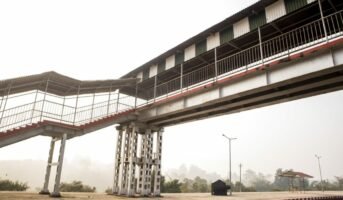Delhi-Panipat Regional Rapid Transit System (RRTS) is an upcoming rail corridor that will revolutionise the transit between Delhi and Panipat, making it faster and convenient for daily commuters. It will cover several important places in Delhi and Haryana on the way and is supposed to greatly enhance connectivity between the two states. Read on to know more about the upcoming Delhi-Panipat RRTS, its route and impact on real estate.
Delhi-Panipat RRTS: Fact file
| States and locale | Delhi, Haryana (NCR) |
| Transit type | Semi-high speed regional rail system |
| Distance covered | 103 km |
| Number of stations | 16 |
| Transit duration | 65 minutes (approx.) |
| Gauge type | Standard |
| Owner | National Capital Region Transport Corporation (NCRTC) |
| Project cost | Rs 21,627 crore |
See also: PM inaugurates Delhi-Ghaziabad-Meerut Regional Rapid Transit System
Delhi-Panipat RRTS: Route and stations
Delhi-Panipat RRTS will commence from Delhi at Sarai Kale Khan, which will allow several interchange facilities as well as connectivity to Nizamuddin Railway Station, Sarai Kale Khan ISBT and the Sarai Kale Khan-Nizamuddin metro station on DMRC’s Pink Line. It will cover 16 stations across Delhi and Haryana on the way before terminating at Panipat Depot Station. Out of the 16 stations covered, six will lie in Delhi and 10 in Haryana. Here is the complete route and list of stations covered:
| State | Stations covered |
| Delhi | Sarai Kale Khan, Indraprastha, Kashmere Gate, Burari Crossing, Mukarba Chowk, Alipur |
| Haryana | Kundli, KMP Interchange, Rajiv Gandhi Education City, Murthal, Barhi, Gannaur, Samalkha, Panipat South, Panipat North, Panipat Depot Station |

Inter connectivity
Delhi-Panipat RRTS has been planned in a way that boosts inter-connectivity with other road and rail links. Here are the stations on this route that are connected to other important transport systems:
Sarai Kale Khan
The termination point of the transit route in Delhi is well-connected to rail, roadways and metro routes. You can easily reach Hazrat Nizamuddin Railway Station, Sarai Kale Khan ISBT and the Sarai Kale Khan-Nizamuddin metro station on Delhi Metro’s Pink Line from here. Moreover, this station will also facilitate interchange for the upcoming Delhi-Alwar RapidX and Delhi-Meerut RapidX rail lines as well.
Indraprastha
The station as Indraprastha will be built in close proximity to the Indraprastha metro station on DMRC’s Blue Line, that connects Vaishali and Noida Electronic City to Dwarka Sector 21. The Blue Line of Delhi Metro covers several important places such as Yamuna Bank, Mandi House, Rajiv Chowk and Dwarka.
Kashmere Gate
You can easily reach Kashmere Gate ISBT and Kashmere Gate metro station from this station on the transit route. Kashmere Gate metro station offers interchange facilities to three metro lines of the Delhi Metro, namely Yellow (Millenium City Centre Gurugram – Samaypur Badli), Red (Rithala – Shaheed Sthal) and Violet (Raja Nahar Singh – Kashmere Gate), offering connectivity across the NCR region.
Burari Crossing
The station at Burari Crossing will be built close to the metro station here that falls on the Pink Line of Delhi Metro. This line connects Maujpur-Babarpur to Majlis Park and covers important localities like Anand Vihar, Mayur Vihar, INA, Sarojini Nagar, Delhi Cantt and more.
Mukarba Chowk
The Mukarba Chowk station will be well-connected to the metro station here on Delhi Metro’s Magenta Line. The Magenta Line connects Botanical Garden to Janakpuri West via Kalkaji Mandir, Hauz Khas, Sadar Bazar, IGI Airport T1 and Vasant Vihar.
See also: Delhi-Meerut Metro: RRTS stations, route and latest updates
Impact on real estate
Delhi-Panipat RRTS will make the process of commuting faster, cheaper and more convenient, leading to more people taking up employment opportunities in the vicinity of the areas connected by this route. This will lead to economic growth in the region, which will lead to a rise in demand for real estate. Properties in the vicinity of the stations on this route will witness major appreciation due to convenient access to amenities brought by the RRTS.
FAQs
What does RRTS stand for?
RRTS stands for rapid rail transit system.
How many stations will be covered by Delhi-Panipat RRTS?
Delhi-Panipat RRTS will cover 16 stations.
What are the termination points of Delhi-Panipat RRTS?
Delhi-Panipat RRTS terminates at Sarai Kale Khan in Delhi and Panipat Depot Station in Haryana.
What is the distance covered by Delhi-Panipat RRTS?
Delhi-Panipat RRTS covers a distance of 103 km.
How long will the RRTS take to cover its entire distance?
The entire distance of the RRTS will be covered in 65 minutes.
How many stations does the RRTS cover in Delhi?
The RRTS covers six stations in Delhi and the rest in Haryana.
Are the stations on the RRTS well-connected with other transport systems?
Yes, several stations on the RRTS are well-connected to railway, roadway and metro systems.
| Got any questions or point of view on our article? We would love to hear from you. Write to our Editor-in-Chief Jhumur Ghosh at [email protected] |

Riddhi Chatterji is currently pursuing a master’s degree in English literature from University of Delhi. Her meticulous attention to detail and the desire to make a learning experience out of every opportunity has allowed her to work with different forms of textual content for digital platforms, ranging from social media to news desks. When not working or studying , you can find her with her head buried in a book, discovering new music and movies, or out and about exploring the city on the metro.











